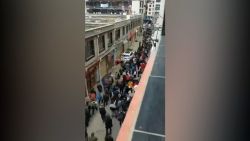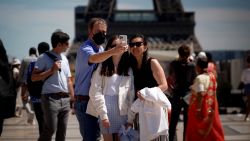A postcard of kangaroos lounging among gumtrees arrives in our letterbox in London, addressed to my 4-year-old daughter.
“My darling,” it says. “How are you? Are you enjoying school? Do you have friends? Your brother is one year old now. I hope you can come and see me in Australia one day. I love you and think of you often – from ‘Nana in Australia.’”
“Nana in Australia” is the pixelated face on my laptop, the voice cutting out on my phone.
She lives on the other side of the world, in a place where Covid-19 doesn’t exist, or at least not to the degree that it has ravaged the United Kingdom with a terrifying ferocity.
For much of 2020, Australia’s success in controlling the virus was the envy of the world. By March of that year, as Italian hospitals drowned in cases and the UK dithered about restrictions, Australia decisively closed its borders – and the tactic initially paid off.
A country of 25 million people, it has recorded just over 900 coronavirus-related deaths since the pandemic began. Its total case numbers are around 32,000 – a figure the UK is exceeding daily. And its economy has bounced back.
But more than a year on, Australians remain shut inside their gilded cage, relying on a series of short, sharp lockdowns to quell an outbreak of the highly-contagious Delta variant.

More than half the population – including those in state capitals Sydney, Melbourne and Adelaide – are again living under lockdown measures following dozens of new cases.
While other Western countries surge ahead with their vaccination rollouts and begin to reopen, Australia’s has been achingly slow. Just over 11% of Australians are fully vaccinated – the lowest of the OECD’s 38 countries.
“Fortress Australia” is now facing uncomfortable questions about just how far this island sanctuary is willing to go to protect itself from external threats – including raising the drawbridge to its own citizens.
Australians have been willing to “put up with restrictions which elsewhere in the democratic world would have been entirely politically impossible,” said Marc Stears, director of the Sydney Policy Lab at the University of Sydney.
That’s because these restrictions speak to “quite a deep cultural sense that danger lurks overseas, and the best thing that Australia can do in these moments is cut itself off from the world,” Stears added.
The challenge now is how to rejoin it.

‘Couldn’t quite believe our luck’
As a kid growing up in Australia, I always believed my home was the “Lucky Country” – a beautiful, peaceful nation with cool marsupials and the best Olympic swimmers.
It was only later I realized that “Lucky Country” was an ironic phrase, penned by author Donald Horne in the 1960s: “Australia is a lucky country run mainly by second rate people who share its luck.”
Nonetheless “Lucky Country” has, over the decades, become a term of endearment for a prosperous nation which boasts some of the “world’s most liveable cities.”
Australia’s good fortune held steady at the start of the pandemic, when the country closed its borders “just in time,” said Stears. What’s more, it “had that remarkable stroke of luck that there wasn’t very much community transmission,” he said.
For much of last year, life in Australia went on relatively unchanged: A friend in Cairns continued cheering on his local basketball team at packed games. A cousin on the Gold Coast talked of crowds at music concerts.
Aside from Melbourne, which underwent one of the strictest lockdowns in the world, “the rest of the country couldn’t quite believe its luck,” said Stears. “There was a real sense of: ‘Oh gosh, we’ve dodged a bullet here.’”

Closing the borders was a crucial part of the “Lucky Country’s” zero-Covid strategy, but experts say the policy has also roused a fearful and isolationist instinct.
“There is a strong protectionist streak in the national psyche,” said Tim Soutphommasane, professor of sociology and political theory at the University of Sydney and Australia’s former race discrimination commissioner.
“In the past, this had its most potent expression in the form of the White Australia immigration policy,” said Soutphommasane, referring to historical racial policies that barred non-European immigrants.
“Obviously that’s no longer in place,” he said. “But the sentiment remains there under the surface. There remains a strong reflex of closing down our borders to any perceived threat.”
It brings to mind the anti-asylum seeker rhetoric that emerged under former Prime Minister John Howard in the 1990s and 2000s. His famous quote: “We will decide who comes to this country and the circumstances in which they come” has been a key issue in almost every federal election since.
And with another election due next year, current Prime Minister Scott Morrison won’t be flinging open the doors anytime soon, said Latika Bourke, London-based journalist with Australian newspapers The Sydney Morning Herald and The Age.
“This is a country that puts cities of millions into lockdowns over one, or two, or three cases,” she said. Morrison is “not going to want to risk a major outbreak, or general circulation of this virus in the country, even if everyone’s had their vaccine, probably before the election.”

The public has so far been largely supportive of the decision to close the borders. According to one recent poll from public broadcaster the ABC, almost 80% of Australians questioned agreed the country’s international borders should stay shut until the pandemic is under control globally.
They have seen how quickly the virus can spread, even in countries with advanced health systems. Health officials give daily press conferences updating local numbers, however small. Local clusters are invariably linked back to leaks from hotel quarantine where returning travelers must spent 14 days in isolation.
Cutting the number of returning travelers is seen as an easy way to relieve pressure on the system, as contact tracers gather information on exposure sites and state leaders impose local restrictions and lockdowns.
But the latest series of lockdowns are testing Australians’ patience, with protests against the new restrictions on Saturday drawing thousands across the nation’s major cities.
And frustration is growing over the country’s woeful vaccine rollout. The government initially planned to fully vaccinate all adults by the end of October. On Thursday, an increasingly under pressure Morrison said he was “sorry” Australia hadn’t been able to meet its targets.

Locked in
On a dreary winter evening, Melbourne’s fifth lockdown grinds on for Genevieve Neve, a 38-year-old actor, originally from San Diego, who moved to Australia as a teenager with her family.
“Australia was a penal colony, and it kind of feels like that now,” she said. “We feel like prisoners in this country.”
The lockdowns have been tough financially on Neve, her tattooist husband and their 2-year-old daughter; she says they have received little government assistance while unable to work.
Emotionally, too, the situation has taken a toll: Neve couldn’t attend her aunt’s funeral in the United States.
Over the past year she’s watched the tables turn in her homeland. “This time last year I felt a lot better living in Australia than I did America, because it seemed quite chaotic over there,” she said. But under the Biden administration’s vaccine rollout, she feels there’s “more of a sense of hope in the States.”
Neve is “dying to get vaccinated,” she said, but: “I’m too young.”
Jabs are being offered to people over 40 and other eligible groups including health care and elder-care workers, those with disabilities, and Aboriginal and Torres Strait Islander people over the age of 16.

A generational divide is now emerging in Australia, with lockdowns and closed borders disproportionately affecting younger people, according to Soutphommasane.
Many young lives had been put “on hold,” he said. Young people had been denied the “opportunities and freedoms previous generations have enjoyed, if not taken for granted.”
The government’s lack of urgency in procuring vaccines – Morrison said Australia could enjoy a “front row seat” to watch immunization rollouts in other countries – has meant the country has so far had a limited supply to draw on.
It had planned to vaccinate most Australians with AstraZeneca doses produced within the country. But fears over blood clots changed the official health advice, meaning most Australians are now waiting for Pfizer vaccines that are yet to be delivered.
People under 40 haven’t been formally offered the first dose of Pfizer, due to low supplies, so the government has invited them to take the surplus stock of AstraZeneca vaccine, but only after consulting their doctor.
The mixed messaging over AstraZeneca has undermined public confidence in the vaccine, with many people content to “wait for Pfizer,” said Soutphommasane.
“Unfortunately, many Australians believe there are only two real choices: Either bunker down in ‘Fortress Australia’ for as long as necessary, or allow the virus to let rip in the community,” he said.
But Soutphommasane believes there is a third way: “Vaccinate as quickly as possible, and have a staged, controlled and safe reopening of Australia.”
Locked out
Outside the country, patience is also wearing thin. There are around 37,300 Australians registered overseas who want to return home, according to the Department of Foreign Affairs and Trade (DFAT).
Since the start of the pandemic, DFAT has helped more than 50,400 Australians get home – including more than 22,400 on 150 government facilitated flights, it told CNN.
But many remain unable to obtain travel exemptions or to stump up the thousands of dollars in airfare and hotel quarantine costs. At one point, those returning from India even faced the prospect of five years in jail or $50,000 fines, if they breached a temporary ban on flights from the country during the peak of India’s second Covid wave.
The countless stories of expats missing out on saying goodbye to dying relatives, meeting their newborn children or having spouses by their side during cancer treatment, have raised “only modest levels of public sympathy,” said Soutphommasane.
Compassion for their plight is all in the “eye of the beholder,” said Bourke.
“From the average, onshore Australian’s view, compassion is not letting tens of thousands of your citizens die. Compassion is not letting your borders remain open to allow that virus to spread,” she said.
Meanwhile, for Australians outside the country, “compassion is not needing to lock out your own citizens in order to achieve health outcomes,” said Bourke.

Angela O’Connell, a 39-year-old teacher from Australia, moved to Singapore six years ago along with her Australian husband and two children. Their work contracts end later this year, and the family is now expecting to pay up to 12,000 Australian dollars ($8,800) for airfares and quarantine fees to return home.
“Never in my mind would I ever think that there would be a possibility that your own country would shut the borders on you,” she said, the sound of traffic on Singapore’s Orchard Road roaring in the background.
“When I think of past disasters, it’s always been: ‘Get our people home.’ This one seems to be very different.”
Before the pandemic, being an expat was always viewed as a “very positive thing,” said O’Connell. “I think we’re bringing back great skills from where we’ve come from, and a different world view.”
But with Covid-19, she said the mood had changed. “Suddenly it was like, ‘oh no, they shouldn’t have gone over there.’”
Georgina Scholes, a 39-year-old Australian living in Denmark with her Danish husband and two children, always thought she would return home at some point, “because I want my kids to grow up a little bit Australian.” Those plans have now been put on hold indefinitely; her Australian family is yet to meet her five-month-old son.
Scholes initially supported Australia’s coronavirus elimination strategy. But she now casts doubt over whether such a policy is achievable anywhere in the world – particularly in Europe, she said, where “it’s not as possible to just lock the borders and keep people out.”
Speaking to fellow Australians locked both in and out of the country, the question that comes up time and time again is: How long can this go on for?
Meanwhile, back home, “Nana in Australia” waits for her second jab, waits for a 4-year-old’s postcard and waits to cuddle a 1-year-old grandson she’s never met.



















